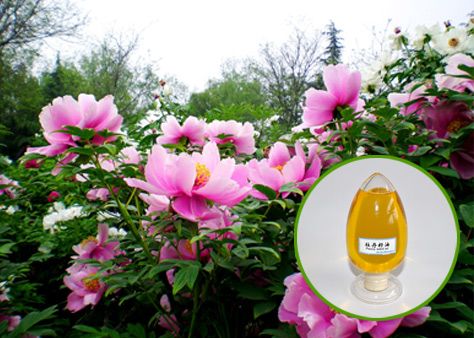The proportion of linoleic acid in peony seed oil is 23.34%.
1. Linoleic acid is a component of cells, especially involved in the synthesis of mitochondria and membrane phosphatides. Lack of linoleic acid may lead to mitochondrial swelling and changes in cell membrane organization, function, membrane permeability, and brittleness.
2. Linoleic acid is closely related to lipid metabolism. Cholesterol in the body must be combined with fatty acids to be transferred in the body for normal metabolism. In the absence of linoleic acid, the blocking of cholesterol transport can not be carried out normally and it will deposit in the body and eventually cause disease.
3. Linoleic acid is a prerequisite for the synthesis of prolactin. The body lacks linoleic acid, and the ability to form prostanosteroids will diminish. Linoleic acid also protects against some skin damage caused by X-rays.
4. Peony seed oil not only can prevent cardiovascular and cerebrovascular diseases but also has unique effects in the treatment of fatty liver.
5. Another effect of linoleic acid is the raw material that makes up the cell membrane. The material that makes up the cell membrane is unsaturated fatty acids. Linoleic acid enhances metabolism and enhances cell viability.
Peony seed oil is not only rich in nutrients but also rich in unique biological active substances. α-linolenic acid is the most basic and most essential material in the evolution of human life. It is the main element of synthetic cell membranes and can be used both internally and externally, with blood circulation. Antibacterial, anti-inflammatory and antiseptic, promote cell regeneration, activate peripheral nerves, lower blood pressure, reduce blood fat, lose weight, etc., external use can be beauty, eliminate pigment deposition, reduce wrinkles, make skin delicate and smooth, full of elasticity. External use also has miraculous effects on the treatment of oral ulcers, rhinitis, arthritis, and skin diseases (including acne, athlete's foot, hand, foot, skin, upper body, blistering, eczema, redness, itching, etc.).

Nucleic Acid (DNA/RNA) Extraction Kit
1. Introduction
The total viral nucleic acid extraction kit is suitable for extracting total viral nucleic acid from serum, plasma, tissue homogenate and other samples. The kit is based on silica column purification technology, which eliminates the need for toxic phenol-chloroform extraction and time-consuming alcohol precipitation. This product has successfully extracted nucleic acids from hepatitis B A/C, hepatitis C, and norovirus standard. The obtained DNA/RNA can be directly used in a series of downstream experiments such as PCR, RT-PCR, and LAMP.
Notice:
1. The carrier RNA solid must be dissolved in Nuclease Free Water to 1µg/µl before use, and vortex to dissolve. Store in aliquots at -70°C. If you need to store it at -20℃ for a long time, please repackage it according to the number of times of use.
2. Dissolve Proteinase K (20mg/ml): Add Proteinase Dissolve Buffer to dissolve Proteinase K to a final concentration of 20mg/ml. Proteinase K dry powder can be stored at 2-8°C for one year, but dissolved Proteinase K must be stored in aliquots at -20°C. Repeated freezing and thawing of Proteinase K can affect its activity.
3. Buffer VHB must be diluted with 14 ml absolute ethanol before use and stored at room temperature.
4. Buffer RW2 must be diluted with 80 ml of absolute ethanol before use and stored at room temperature.
3. Shelf life
Except for Proteinase K and Carrier RNA, other components of this product can be stored at room temperature (15-25°C) for 12 months, and should be stored at 2-8°C for long-term storage. Proteinase K and Carrier RNA dry powder are transported at room temperature. Please store at -20°C after receiving the test product, and store at -20°C after dissolving.
Nucleic Acid Extraction Reagent Kit,Nucleic Acid Extraction Kit,Covid-19 Nucleic Acid Extraction Reagents,Nucleic Acid Test Kits
Jilin Sinoscience Technology Co. LTD , https://www.jlgkscience.com